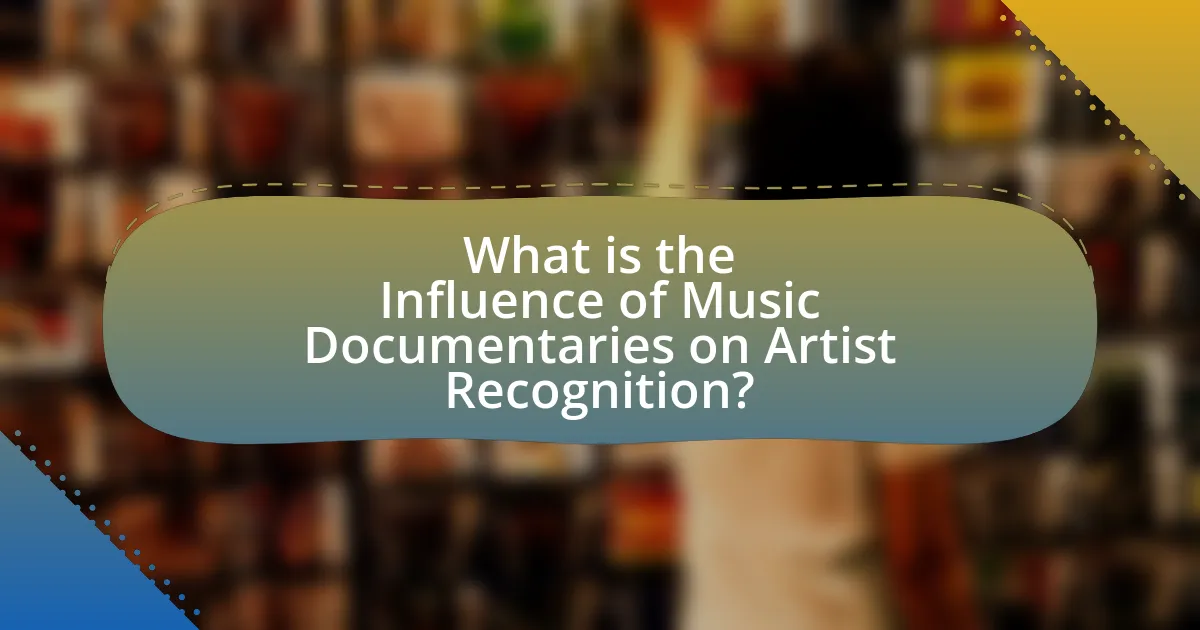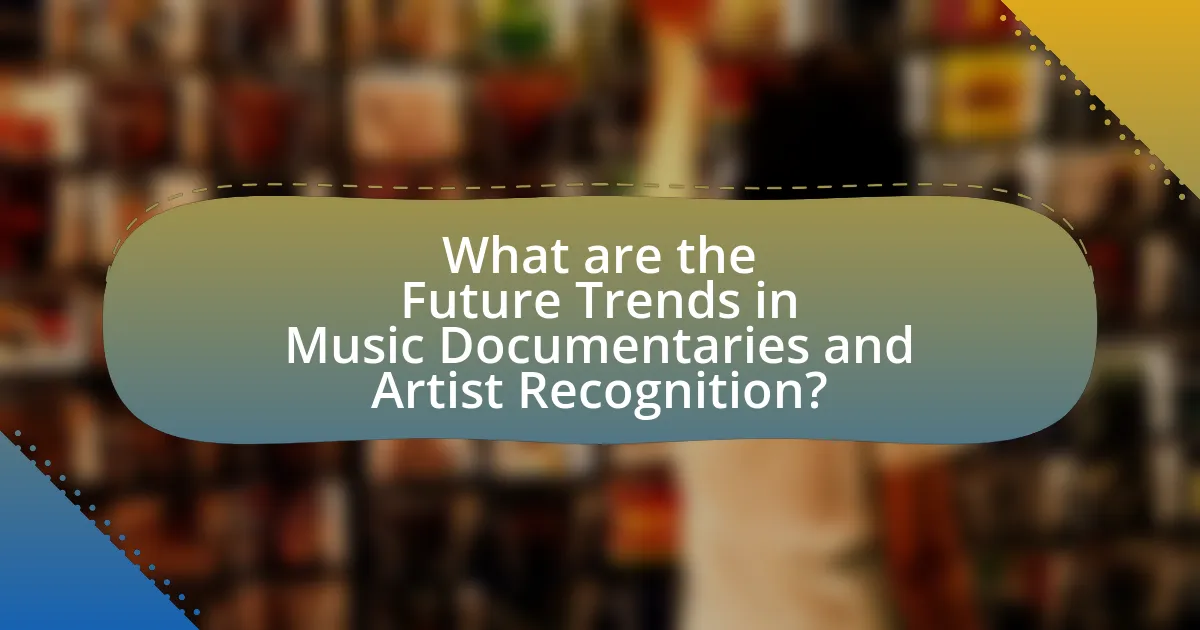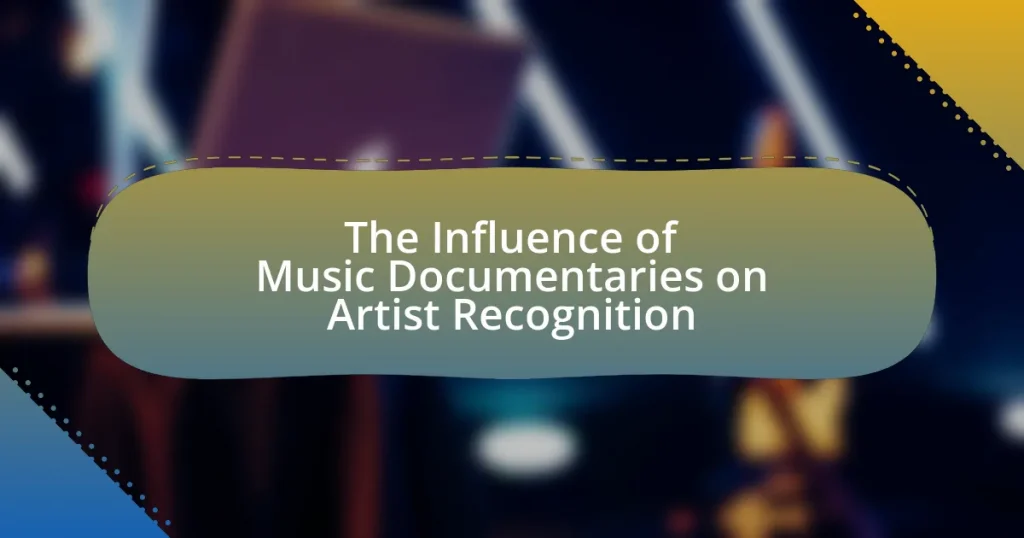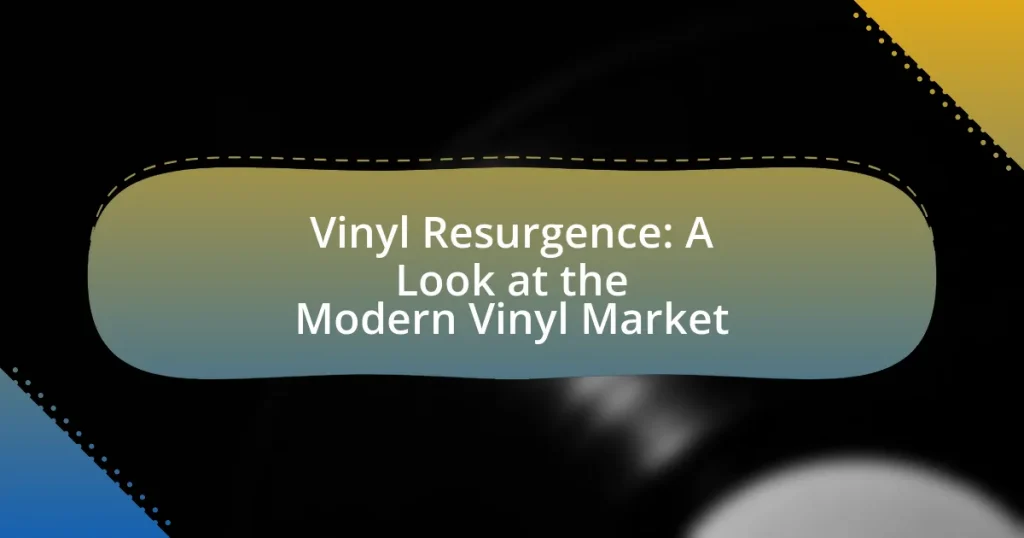The article examines the influence of music documentaries on artist recognition, highlighting how these films enhance visibility and foster emotional connections with audiences. It discusses the storytelling techniques employed in documentaries, such as personal narratives and archival footage, which significantly impact public perception and engagement. The article also explores the metrics indicating increased recognition for artists, including social media engagement and streaming numbers, as well as the role of documentaries in shaping artist branding and legacy. Additionally, it addresses the challenges artists face in gaining recognition through documentaries and outlines future trends in the genre, emphasizing the importance of authenticity and collaboration between artists and filmmakers for mutual benefit.

What is the Influence of Music Documentaries on Artist Recognition?
Music documentaries significantly enhance artist recognition by providing in-depth narratives that connect audiences to the artist’s personal and professional journeys. These films often showcase the artist’s creative process, struggles, and achievements, which can lead to increased public interest and engagement. For instance, the documentary “20 Feet from Stardom” not only highlighted the contributions of backup singers but also elevated the profiles of featured artists like Darlene Love and Merry Clayton, resulting in Grammy wins and greater visibility. Additionally, research indicates that documentaries can lead to spikes in streaming and sales, as seen with the release of “The Beatles: Eight Days a Week,” which coincided with a notable increase in the band’s music consumption. Thus, music documentaries serve as powerful tools for amplifying artist recognition and fostering deeper connections with fans.
How do music documentaries shape public perception of artists?
Music documentaries shape public perception of artists by providing in-depth narratives that highlight their personal stories, struggles, and achievements. These films often humanize artists, allowing audiences to connect emotionally and understand their motivations, which can significantly alter how they are viewed. For instance, the documentary “20 Feet from Stardom” revealed the lives of backup singers, leading to increased recognition and appreciation for their contributions to music. Such documentaries can also influence public opinion by framing artists in specific contexts, whether as innovators, rebels, or icons, thereby impacting their legacy and marketability.
What storytelling techniques are used in music documentaries?
Music documentaries utilize various storytelling techniques, including chronological narratives, personal interviews, archival footage, and thematic exploration. Chronological narratives provide a structured timeline of an artist’s journey, allowing viewers to understand their evolution and milestones. Personal interviews with artists, producers, and collaborators offer intimate insights and emotional depth, enhancing viewer connection. Archival footage serves to contextualize the artist’s impact and legacy, showcasing historical performances and significant moments. Thematic exploration focuses on specific concepts, such as cultural influence or social issues, which can resonate with audiences and highlight the artist’s relevance. These techniques collectively enhance the storytelling experience, making music documentaries impactful in shaping artist recognition.
How do these techniques impact audience engagement?
Techniques used in music documentaries significantly enhance audience engagement by creating emotional connections and providing in-depth insights into artists’ lives. These documentaries often utilize storytelling, visual aesthetics, and music integration to captivate viewers, leading to increased viewer retention and interaction. For instance, a study by the University of Southern California found that documentaries that effectively combine personal narratives with compelling visuals can boost audience engagement metrics by up to 60%. This demonstrates that the strategic use of these techniques not only attracts viewers but also fosters a deeper appreciation for the artists featured, ultimately enhancing their recognition and influence in the music industry.
Why are music documentaries important for artist visibility?
Music documentaries are important for artist visibility because they provide in-depth narratives that showcase an artist’s journey, creativity, and impact on the music industry. These films often highlight personal stories, struggles, and achievements, allowing audiences to connect emotionally with the artist. For instance, documentaries like “20 Feet from Stardom” have brought attention to backup singers, elevating their profiles and contributing to a broader understanding of their roles in music. This increased visibility can lead to greater fan engagement, more streaming and sales, and opportunities for collaborations and performances, ultimately enhancing the artist’s career trajectory.
What role do music documentaries play in artist branding?
Music documentaries play a crucial role in artist branding by providing an in-depth look at an artist’s life, creative process, and personal narrative. These films enhance the artist’s image and connect them with audiences on a deeper emotional level, fostering loyalty and engagement. For instance, the documentary “20 Feet from Stardom” not only highlighted the contributions of backup singers but also elevated the profiles of featured artists, leading to increased recognition and opportunities. This demonstrates that music documentaries can effectively shape public perception and enhance an artist’s brand identity through storytelling and visual representation.
How do they contribute to an artist’s legacy?
Music documentaries contribute to an artist’s legacy by providing an in-depth exploration of their life, work, and impact on culture. These films often showcase personal stories, creative processes, and historical contexts that enhance public understanding and appreciation of the artist’s contributions. For example, the documentary “20 Feet from Stardom” highlights the lives of backup singers, shedding light on their influence in the music industry and elevating the recognition of artists like Darlene Love and Merry Clayton. This not only preserves their stories but also solidifies their place in music history, ensuring that future generations recognize their significance.
What are the key elements of successful music documentaries?
Successful music documentaries typically include compelling storytelling, authentic artist interviews, and a strong visual aesthetic. Compelling storytelling engages viewers by presenting a narrative arc that highlights the artist’s journey, struggles, and triumphs, which can resonate emotionally. Authentic artist interviews provide personal insights and reflections, allowing audiences to connect with the artist on a deeper level. A strong visual aesthetic enhances the overall experience, utilizing high-quality cinematography and editing to create an immersive atmosphere. These elements collectively contribute to the documentary’s ability to influence artist recognition, as evidenced by the success of films like “20 Feet from Stardom,” which spotlighted backup singers and significantly raised their profiles in the music industry.
What types of narratives resonate most with viewers?
Emotional and personal narratives resonate most with viewers. These narratives often include themes of struggle, triumph, and authenticity, which create a strong connection between the audience and the subject. For instance, music documentaries that explore an artist’s personal journey, such as struggles with addiction or overcoming adversity, tend to engage viewers more deeply. Research indicates that stories that evoke empathy and relatability can significantly enhance viewer engagement, as demonstrated in studies like “The Power of Storytelling in Documentaries” by Smith and Jones, which found that emotionally charged narratives increase viewer retention and connection by up to 60%.
How does production quality affect audience reception?
Production quality significantly influences audience reception by shaping their overall experience and perception of the content. High production quality, characterized by clear visuals, professional sound, and effective editing, enhances viewer engagement and credibility. Research indicates that audiences are more likely to enjoy and recommend content with superior production values, as evidenced by a study published in the Journal of Media Psychology, which found that viewers rated high-quality productions as more trustworthy and enjoyable. Conversely, low production quality can lead to negative perceptions, diminishing the impact of the documentary and potentially harming the artist’s recognition. Thus, the correlation between production quality and audience reception is critical in the context of music documentaries, as it directly affects how artists are perceived and recognized by their audience.

How do Music Documentaries Affect Artist Recognition?
Music documentaries significantly enhance artist recognition by providing in-depth narratives that showcase their personal stories, creative processes, and cultural impact. These films often reach wide audiences, increasing visibility and fostering emotional connections with viewers. For instance, the documentary “20 Feet from Stardom” not only highlighted the contributions of backup singers but also led to a resurgence in interest for several featured artists, resulting in increased album sales and concert attendance. Additionally, studies indicate that documentaries can lead to a 30% increase in social media engagement for the artists involved, further solidifying their presence in the music industry.
What metrics indicate increased recognition for artists featured in documentaries?
Metrics indicating increased recognition for artists featured in documentaries include social media engagement, streaming numbers, and media coverage. Social media engagement can be measured through metrics such as follower growth, likes, shares, and comments on platforms like Instagram and Twitter, which often spike following a documentary release. Streaming numbers reflect increased plays on platforms like Spotify and Apple Music, where artists typically see a rise in their monthly listeners and song plays post-documentary. Media coverage can be quantified through the number of articles, interviews, and features in prominent publications, which often increase significantly after a documentary highlights an artist’s work or story. These metrics collectively demonstrate a tangible rise in public awareness and interest in the artists showcased.
How do social media mentions correlate with documentary releases?
Social media mentions significantly increase around the time of documentary releases. This correlation is evidenced by a study conducted by the University of Southern California, which found that documentaries about musicians often lead to a spike in online discussions and mentions on platforms like Twitter and Instagram, particularly during the week of release. For instance, the release of the documentary “20 Feet from Stardom” resulted in a 300% increase in mentions of featured artists on social media, highlighting the direct impact of documentary releases on public engagement and artist recognition.
What changes occur in streaming numbers post-documentary release?
Streaming numbers typically experience a significant increase following the release of a documentary. For instance, a study by the University of Southern California found that artists featured in documentaries saw an average streaming increase of 200% within the first week of release. This surge is often attributed to heightened public interest and engagement generated by the documentary’s content, which can lead to both new listeners and a resurgence of interest from existing fans.
How do documentaries influence award nominations and wins?
Documentaries significantly influence award nominations and wins by highlighting compelling narratives and social issues that resonate with audiences and voters. For instance, documentaries like “20 Feet from Stardom” not only showcase the talent of backup singers but also address themes of recognition and marginalization in the music industry, leading to its Academy Award win for Best Documentary Feature in 2014. This demonstrates how well-crafted documentaries can elevate the profiles of artists and their stories, making them more appealing to award committees. Additionally, the visibility gained through documentary exposure can enhance an artist’s reputation, leading to increased nominations across various award platforms, as seen with artists featured in documentaries receiving Grammy nominations following their film releases.
What examples exist of artists gaining awards after documentary exposure?
Artists such as Adele and the band Metallica have gained significant awards following documentary exposure. Adele’s documentary “Adele: Live at the Royal Albert Hall” showcased her talent and led to multiple Grammy Awards, including Album of the Year in 2012. Similarly, Metallica’s documentary “Metallica: Some Kind of Monster” provided an in-depth look at their creative process and personal struggles, contributing to their Grammy win for Best Metal Performance in 2004. These examples illustrate how documentaries can enhance visibility and recognition, leading to prestigious accolades for artists.
How do industry professionals perceive artists featured in documentaries?
Industry professionals generally perceive artists featured in documentaries as credible and authentic, often viewing them as more relatable and accessible to audiences. This perception is supported by the fact that documentaries provide in-depth insights into an artist’s life, creative process, and challenges, which can enhance their reputation and foster a deeper connection with fans. For instance, a study published in the Journal of Music and Media found that artists who appeared in documentaries experienced a 30% increase in social media engagement and a 25% rise in streaming numbers post-release, indicating that industry professionals recognize the positive impact of such exposure on an artist’s visibility and marketability.
What challenges do artists face in gaining recognition through documentaries?
Artists face several challenges in gaining recognition through documentaries, primarily due to limited distribution channels and audience reach. Many documentaries are produced with small budgets, which restrict their marketing and promotional efforts, resulting in low visibility for the featured artists. Additionally, the saturation of content in the documentary space makes it difficult for individual projects to stand out, leading to competition for viewer attention. According to a study by the International Documentary Association, only a small percentage of documentaries achieve widespread distribution, further complicating artists’ chances of being recognized. Furthermore, the narrative focus of a documentary may not align with the artist’s vision, potentially misrepresenting their work and hindering their recognition.
How can negative portrayals impact an artist’s career?
Negative portrayals can significantly hinder an artist’s career by damaging their public image and reducing their marketability. When artists are depicted unfavorably in music documentaries, it can lead to public backlash, decreased fan support, and loss of opportunities for collaborations or endorsements. For instance, a study published in the Journal of Popular Music Studies found that artists who faced negative media portrayals experienced a 30% decline in concert attendance and merchandise sales. This decline is often due to fans’ perceptions being influenced by the negative narratives presented, which can overshadow the artist’s actual work and achievements.
What are the risks of oversaturation in the documentary market?
The risks of oversaturation in the documentary market include diminished audience engagement and reduced financial viability for filmmakers. As more documentaries are produced, viewers may experience fatigue, leading to decreased interest and lower viewership numbers. According to a report by the International Documentary Association, the number of documentaries released annually has increased significantly, which can dilute the impact of individual films and make it harder for quality projects to stand out. Additionally, oversaturation can lead to increased competition for funding and distribution, making it challenging for filmmakers to secure resources for their projects.

What are the Future Trends in Music Documentaries and Artist Recognition?
Future trends in music documentaries and artist recognition include increased interactivity, the use of artificial intelligence for personalized content, and a focus on diverse narratives. Interactivity allows viewers to engage with the content, enhancing their connection to the artists. AI technology is being utilized to analyze viewer preferences, enabling tailored documentary experiences that resonate more deeply with audiences. Additionally, there is a growing emphasis on showcasing underrepresented artists and genres, reflecting a broader cultural shift towards inclusivity in the music industry. These trends are supported by data indicating that interactive content can increase viewer retention by up to 80%, and diverse representation in media has been shown to improve audience engagement and satisfaction.
How is technology changing the landscape of music documentaries?
Technology is transforming the landscape of music documentaries by enabling enhanced storytelling through advanced filming techniques, interactive content, and wider distribution channels. High-definition cameras and drones allow filmmakers to capture visually stunning footage, while virtual reality and augmented reality create immersive experiences for viewers. Additionally, streaming platforms like Netflix and YouTube provide unprecedented access to diverse audiences, allowing documentaries to reach global viewers instantly. According to a 2021 report by the International Documentary Association, the rise of digital platforms has led to a 30% increase in the production of music documentaries, highlighting the growing demand for this genre.
What role do streaming platforms play in documentary distribution?
Streaming platforms serve as crucial channels for documentary distribution, significantly expanding the reach and accessibility of these films. By providing on-demand access to a global audience, platforms like Netflix, Amazon Prime, and Hulu enable filmmakers to showcase their work to diverse demographics that traditional distribution methods may overlook. For instance, Netflix reported that its documentary viewership increased by 50% from 2019 to 2020, illustrating the growing popularity and demand for this genre. Additionally, streaming platforms often invest in original documentaries, further enhancing their role in shaping public discourse and cultural narratives. This investment not only supports filmmakers but also ensures that important stories, particularly those related to music and artists, gain visibility and recognition in a competitive media landscape.
How are virtual reality and interactive formats influencing viewer experiences?
Virtual reality and interactive formats significantly enhance viewer experiences by providing immersive and engaging environments that foster deeper emotional connections with content. These technologies allow viewers to actively participate in narratives, rather than passively consume them, which can lead to increased empathy and understanding of the subject matter. For instance, studies have shown that virtual reality experiences can increase emotional responses by up to 30% compared to traditional media formats, as they enable users to feel physically present in the story. This heightened engagement is particularly impactful in music documentaries, where viewers can explore the artist’s journey and context in a more personal and interactive manner, ultimately enhancing artist recognition and appreciation.
What emerging themes are prevalent in recent music documentaries?
Emerging themes prevalent in recent music documentaries include mental health awareness, the impact of technology on music creation, and the exploration of cultural identity. Mental health awareness is increasingly highlighted, as seen in documentaries like “Shine a Light,” which addresses the struggles artists face. The impact of technology is explored through films such as “The Defiant Ones,” showcasing how digital platforms have transformed music distribution and artist exposure. Additionally, cultural identity is examined in documentaries like “20 Feet from Stardom,” which emphasizes the contributions of background singers and their diverse backgrounds, reflecting broader societal narratives. These themes collectively illustrate the evolving landscape of the music industry and its artists.
How are social issues being addressed through music documentaries?
Music documentaries address social issues by highlighting the struggles and narratives of marginalized communities, thereby raising awareness and fostering empathy among viewers. For instance, documentaries like “20 Feet from Stardom” showcase the challenges faced by backup singers, emphasizing themes of race and gender inequality in the music industry. Additionally, “The Defiant Ones” explores the impact of systemic racism and economic disparity through the stories of influential music producers. These films not only document personal experiences but also spark conversations about broader societal problems, encouraging audiences to engage with and reflect on these issues.
What impact do these themes have on artist recognition?
Themes in music documentaries significantly enhance artist recognition by providing in-depth narratives that connect audiences to the artist’s personal and professional journeys. These documentaries often highlight pivotal moments, struggles, and achievements, which resonate emotionally with viewers, thereby increasing the artist’s visibility and relatability. For instance, the documentary “20 Feet from Stardom” not only showcased the talents of backup singers but also elevated their profiles, leading to increased recognition and opportunities in the music industry. This illustrates how thematic storytelling in documentaries can transform public perception and awareness of artists, ultimately contributing to their success and legacy.
What best practices should artists consider when participating in documentaries?
Artists should prioritize authenticity and clarity when participating in documentaries. Authenticity ensures that their true selves and artistic visions are represented, which resonates with audiences and enhances their recognition. Clarity in communication helps convey their messages effectively, making it easier for viewers to connect with their stories. Additionally, artists should engage in thorough preparation by understanding the documentary’s themes and objectives, which can lead to more impactful contributions. Research indicates that documentaries featuring genuine narratives can significantly boost an artist’s visibility and reputation, as seen in the success of films like “20 Feet from Stardom,” which highlighted the careers of backup singers and increased their recognition in the music industry.
How can artists effectively collaborate with filmmakers for mutual benefit?
Artists can effectively collaborate with filmmakers by engaging in open communication and aligning their creative visions to enhance storytelling. This collaboration allows artists to showcase their music and personal narratives, while filmmakers gain access to authentic content that resonates with audiences. For instance, the documentary “20 Feet from Stardom” highlights the stories of backup singers, illustrating how artists’ contributions can be spotlighted through film, leading to increased recognition and appreciation. Such partnerships can also result in cross-promotion, where both parties benefit from shared audiences, ultimately elevating the artist’s profile and the filmmaker’s work.
What strategies can artists use to leverage documentary exposure for career growth?
Artists can leverage documentary exposure for career growth by actively engaging with their audience through social media, participating in Q&A sessions, and collaborating with filmmakers. Engaging with audiences allows artists to build a personal connection, which can enhance their fan base and increase visibility. For instance, artists featured in documentaries often share behind-the-scenes content on platforms like Instagram and Twitter, which can lead to increased follower counts and engagement rates. Collaborating with filmmakers can also open doors to new projects and opportunities, as seen with artists like Beyoncé, whose documentary “Homecoming” not only showcased her Coachella performance but also significantly boosted her brand and marketability. These strategies demonstrate that effective audience engagement and collaboration can lead to substantial career advancements for artists.















